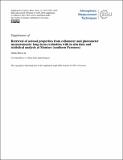Por favor, use este identificador para citar o enlazar a este item:
http://hdl.handle.net/10261/200054COMPARTIR / EXPORTAR:
 SHARE SHARE
 CORE
BASE CORE
BASE
|
|
| Visualizar otros formatos: MARC | Dublin Core | RDF | ORE | MODS | METS | DIDL | DATACITE | |

| Título: | Retrieval of aerosol properties from ceilometer and photometer measurements: Long-term evaluation with in situ data and statistical analysis at Montsec (southern Pyrenees) |
Autor: | Titos, Gloria CSIC ORCID; Ealo, Marina CSIC; Román, Roberto CSIC ORCID; Cazorla, Alberto; Sola, Yolanda; Dubovik, Oleg; Alastuey, Andrés CSIC ORCID; Pandolfi, Marco CSIC ORCID | Palabras clave: | Aerosols Dust Dust aerosols Aerosol properties |
Fecha de publicación: | 19-jun-2019 | Editor: | Copernicus Publications | Citación: | Atmospheric Measurement Techniques 12 (6): 3255-3267 (2019) | Resumen: | Given the need for accurate knowledge of aerosol microphysical and optical properties with height resolution, various algorithms combining vertically resolved and column-integrated aerosol information have been developed in the last years. Here we present new results of vertically resolved extensive aerosol optical properties (backscattering, scattering and extinction) and volume concentrations retrieved with the GRASP (Generalized Retrieval of Aerosol and Surface Properties) algorithm over a 3-year period. The range-corrected signal (RCS) at 1064 nm measured with a ceilometer and the aerosol optical depth (AOD) and sky radiances from a sun/sky photometer have been used as input for this algorithm. We perform a detailed evaluation of GRASP retrievals with simultaneous in situ measurements performed at the same height, at the Montsec mountaintop observatory (MSA) in the Pre-Pyrenees (northeastern Spain). This is the first long-term evaluation of various outputs of this algorithm; previous evaluations focused only on the study of aerosol volume concentration for short-term periods. In general, our results show good agreement between techniques although GRASP inversions yield higher values than those measured in situ. The statistical analysis of the extinction coefficient vertical profiles shows a clear seasonality as well as significant differences depending on the air mass origin. The observed seasonal cycle is mainly modulated by a higher development of the atmospheric boundary layer (ABL) during warm months, which favors the transport of pollutants to MSA, and higher influence of regional and North African episodes. On the other hand, in winter, MSA is frequently influenced by free-troposphere conditions and venting periods and therefore lower extinction coefficients that markedly decrease with height. This study shows the potentiality of implementing GRASP in ceilometer and lidar networks for obtaining aerosol optical properties and volume concentrations at multiple sites, which will definitely contribute to enhancing the representativeness of the aerosol vertical distribution as well as to providing useful information for satellite and global model evaluation. © Author(s) 2019. | Versión del editor: | https://doi.org/10.5194/amt-12-3255-2019 | URI: | http://hdl.handle.net/10261/200054 | DOI: | 10.5194/amt-12-3255-2019 |
| Aparece en las colecciones: | (IDAEA) Artículos |
Ficheros en este ítem:
| Fichero | Descripción | Tamaño | Formato | |
|---|---|---|---|---|
| Retrieval of aerosol properties from ceilometer and photometer measurements. Long-term evaluation with in situ data and statistical analysis at Montsec (southern Pyrenees).pdf | Artículo principal | 594,37 kB | Adobe PDF |  Visualizar/Abrir |
| amt-12-3255-2019-supplement.pdf | Material suplementario | 131,63 kB | Adobe PDF |  Visualizar/Abrir |
CORE Recommender
SCOPUSTM
Citations
25
checked on 18-abr-2024
WEB OF SCIENCETM
Citations
21
checked on 15-feb-2024
Page view(s)
142
checked on 19-abr-2024
Download(s)
137
checked on 19-abr-2024
Google ScholarTM
Check
Altmetric
Altmetric
NOTA: Los ítems de Digital.CSIC están protegidos por copyright, con todos los derechos reservados, a menos que se indique lo contrario.
